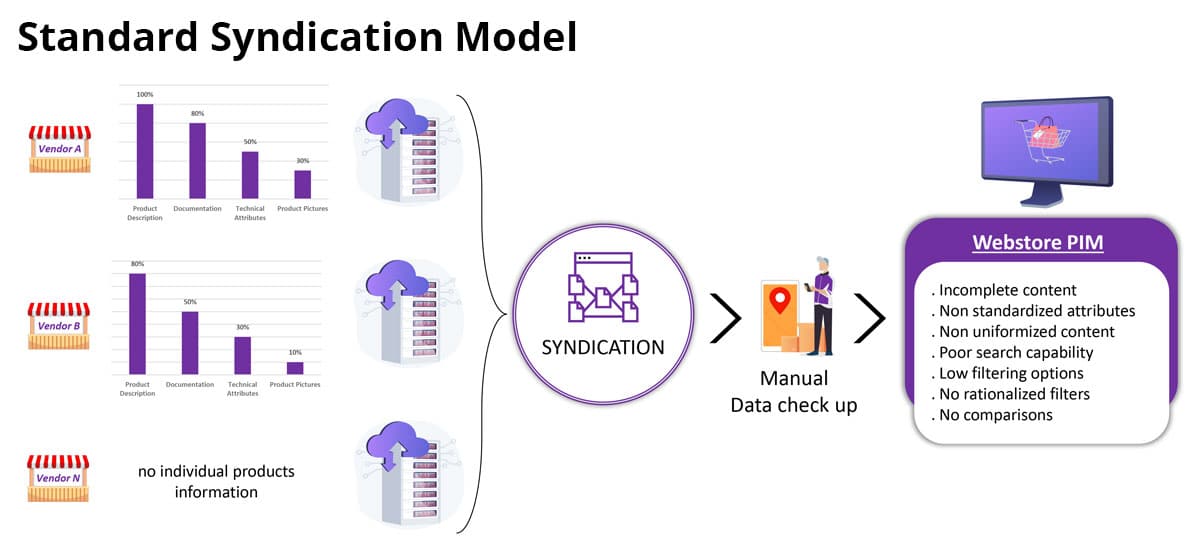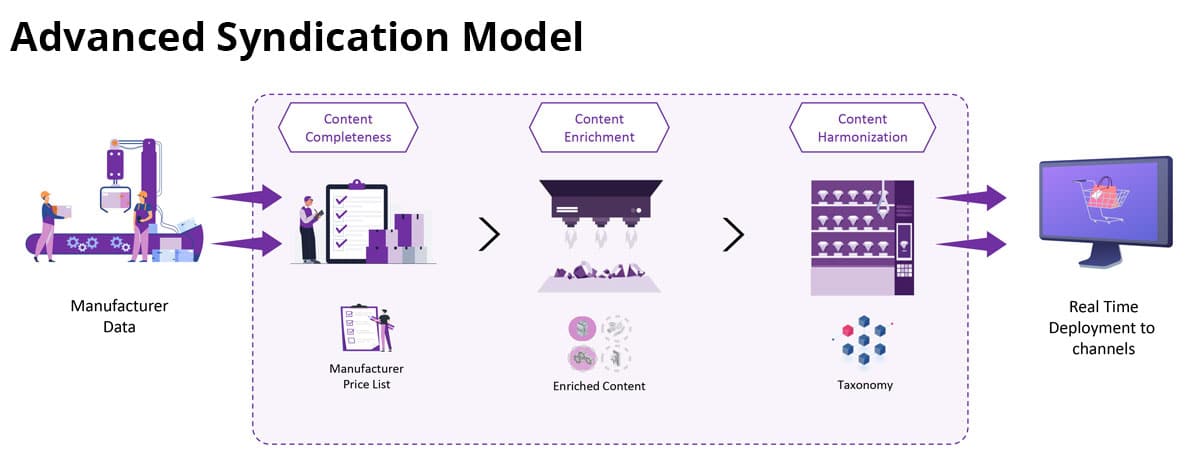Product Data Syndication is a plan or method for a manufacturer to efficiently provide product content to their distribution channel via a third-party organization.
Many progressive companies have concluded they can better use their resources by outsourcing the dissemination of their electronic product data. The company providing this syndication solves three issues.
- First, the syndicator has expertise in data warehousing and electronic distribution of the data.
- Second, the syndicator has strong capabilities in data security.
- Third, the syndicator possesses the support staff required to assist and support connections to channel partners.
Along the way, a great syndicator provides feedback on the effectiveness of the actual use of the data. For example, they provide feedback that includes how often distributors/channel partners are refreshing their data, as well as updates to product specifications, additions of new features and the introduction of new products act to improve the customer experience.
From a commercial standpoint, understanding the percentage of the manufacturer’s catalog downloaded and displayed on the distributor’s website assists in better understanding distributor commitment to the product line.
Simply stated, syndication is a tool for manufacturers to easily and efficiently get information to their partners. There are many variations within the framework of this description. For discussion’s sake, we will break them into two models.
Standard Syndication Model
The most common form of a syndication service provider is a company that simply receives content from a manufacturer and forwards it to the channel with little added, except formatting. If products exist within the manufacturer’s catalog/price list without data, they are typically ignored.

In this model, the syndicator passes along whatever information is provided by the manufacturer. They are a conduit. Poor quality data input from the manufacturer directly affects the ecommerce success of the channel.
This standard syndication model works well only if the manufacturer’s existing content is complete, ecommerce friendly, features the proper search engine optimization (SEO) descriptions and contains some form of cross-selling data. Even then it often needs data stewards at the distributor level to make it work with whatever search tool/PIM/ecommerce system the distributor has chosen.
Sadly, and as proven in a Distribution Strategy Group (DSG) whitepaper, The Manufacturer Omnichannel Index, very few manufacturers utilize these features in the data they maintain:
- 75% of these leading manufacturers do not have individual product pages on their websites.
- 95% of these manufacturers have SEO geared toward product/brand names. Customers use keywords, not catalog numbers or product trade names.
- 90% of manufacturers have less than half of their published U.S. price list searchable on their website. Experience dictates having a plethora of “long tail” products attracts customers and is more profitable for both the manufacturer and distributor.
In addition to these issues, in some instances, the manufacturer’s data was originally developed for a different market, i.e., Europe/Asia versus North America. The subtle differences in nomenclature, standards and regulatory approvals may or may not need to be revised per market.
Finally, and importantly, the syndicator must use great care to ensure the security of the data. Think about this, there are lots of data files to be transferred. A security breach embedded in a file at the manufacturer could quickly be forwarded to every distributor using the service. And a breach at the syndicator similarly would quickly be replicated throughout the entire channel.
Advanced Syndication Model
This model takes syndication to the next level. Without doing deep research, it is easier to see a much higher percentage of the manufacturer’s published price list is covered. It is not uncommon for the standard version of syndication to carry 50% or less of the SKUs covered in the published price list.

Adding the long-tail items has been proven to bring in more new customers while better serving existing customers. Posting all the products available for sale allows a customer searching for some “odd item” to find the product without going to a specialty supplier.
With this model, the percentage of SKUs accompanied by pertinent pictures and detailed product information is much higher. When making a buying decision, customers often search for key attributes and want to see crucial illustrations tied to the product’s application.
There will be harmonized attributes that allow the distributor’s ecommerce system to perform better searches, product comparisons, and filters based on product features. Thinking about how customers will find the products, the data will be arranged with longer and more SEO-focused descriptions.
The best syndicators also have expertise in the mechanics of ecommerce. They understand what is important in the customer’s buying decision and how products interact with one another in the customer’s application. This expertise allows for the creation of filters, comparison tools and the kind of features that make the customer’s buying experience easier.
A syndicator who is also involved in the ecommerce effort may monitor online customer experiences to determine new ways to minimize the amount of effort required by the customer to search and discover appropriate solutions.
Content is King: Syndication Provides an Advantage
Distributors are rapidly making the move to ecommerce. According to Distribution Strategy Group’s 2022 State of Distributor Sales research, nearly 60% of distributors now have some form of web presence. Most don’t have the bandwidth to create their own product data, and some don’t have the bandwidth to handle standard syndication without help from the outside.
Gathering the information and creating the proper data to represent your product is not a good use of distributor resources. Do the math, if your company produces 10,000 SKUs and it takes just five minutes to create the right content per product, that means the distributor has invested 800 hours in content recreation.
Because that effort must be repeated throughout your channel, and distributors need to handle content from dozens to hundreds of suppliers — the resulting time lost is massive. An advanced syndicator armed with the right data gives you a competitive advantage. In the ecommerce game, content is king.
Fabien Legouic is KYKLO co-founder and Chief Technical Officer. He previously worked 12 years for Schneider Electric as a Business Development Director and Senior Marketing Manager. He has extended experience and success in international projects and contracts management, in promotion and prescription of technical solutions to end-users, as well as B2B marketing of industrial and electrical products.

